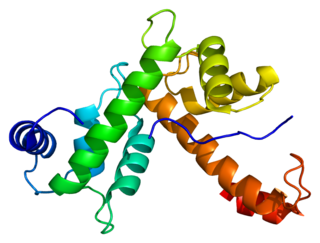Two Melanin-concentrating hormone receptors (MCHR) have recently been characterized: MCH-R1 and MCH-R2. These two receptors share approximately 38% homology.

The G protein-coupled bile acid receptor 1 (GPBAR1) also known G-protein coupled receptor 19 (GPCR19), membrane-type receptor for bile acids (M-BAR) or Takeda G protein-coupled receptor 5 (TGR5) as is a protein that in humans is encoded by the GPBAR1 gene.

Insulin-like growth factor-binding protein 5(IBF-5) is a protein that in humans is encoded by the IGFBP5 gene. An IGFBP5 gene was recently identified as being important for adaptation to varying water salinity in fish.

Bradykinin receptor B2 is a G-protein coupled receptor for bradykinin, encoded by the BDKRB2 gene in humans.

Dual specificity mitogen-activated protein kinase kinase 3 is an enzyme that in humans is encoded by the MAP2K3 gene.

E3 SUMO-protein ligase PIAS4 is one of several protein inhibitor of activated STAT (PIAS) proteins. It is also known as protein inhibitor of activated STAT protein gamma, and is an enzyme that in humans is encoded by the PIAS4 gene.

Somatostatin receptor type 5 is a protein that in humans is encoded by the SSTR5 gene.

Programmed cell death protein 6 is a protein that in humans is encoded by the PDCD6 gene.

The alpha-1A adrenergic receptor, also known as ADRA1A, formerly known also as the alpha-1C adrenergic receptor, is an alpha-1 adrenergic receptor, and also denotes the human gene encoding it. There is no longer a subtype α1C receptor. At one time, there was a subtype known as α1C, but it was found to be identical to the previously discovered α1A receptor subtype. To avoid confusion, the naming convention was continued with the letter D.

The alpha-1B adrenergic receptor (α1B-adrenoreceptor), also known as ADRA1B, is an alpha-1 adrenergic receptor, and also denotes the human gene encoding it. The crystal structure of the α1B-adrenergic receptor has been determined in complex with the inverse agonist (+)-cyclazosin.

G-protein coupled receptor 39 is a protein that in humans is encoded by the GPR39 gene.

Melanin-concentrating hormone receptor 1, also known as MCH1, is one of the melanin-concentrating hormone receptors found in all mammals.

Neuromedin-U receptor 1 is a protein that in humans is encoded by the NMUR1 gene.

Neuromedin-U receptor 2 is a protein that in humans is encoded by the NMUR2 gene.

Nuclear receptor coactivator 6 is a protein that in humans is encoded by the NCOA6 gene.

Serine/threonine-protein kinase D2 or PKD2 is an enzyme that in humans is encoded by the PRKD2 gene.

Triadin, also known as TRDN, is a human gene associated with the release of calcium ions from the sarcoplasmic reticulum triggering muscular contraction through calcium-induced calcium release. Triadin is a multiprotein family, arising from different processing of the TRDN gene on chromosome 6. It is a transmembrane protein on the sarcoplasmic reticulum due to a well defined hydrophobic section and it forms a quaternary complex with the cardiac ryanodine receptor (RYR2), calsequestrin (CASQ2) and junctin proteins. The luminal (inner compartment of the sarcoplasmic reticulum) section of Triadin has areas of highly charged amino acid residues that act as luminal Ca2+ receptors. Triadin is also able to sense luminal Ca2+ concentrations by mediating interactions between RYR2 and CASQ2. Triadin has several different forms; Trisk 95 and Trisk 51, which are expressed in skeletal muscle, and Trisk 32 (CT1), which is mainly expressed in cardiac muscle.

Ras GTPase-activating protein 3 is an enzyme that in humans is encoded by the RASA3 gene.

Low-density lipoprotein receptor-related protein 1B is a protein that in humans is encoded by the LRP1B gene.

Type-1 angiotensin II receptor-associated protein is a protein that in humans is encoded by the AGTRAP gene.
















